|
|
 |
Suzanne Valadon
|
|
French Post-Impressionist Painter, 1865-1938
French painter and artist's model. She led a lonely childhood in Paris as the daughter of an unmarried and unaffectionate maid, seeking refuge from her bleak circumstances by living in a dream world. While residing in the Montmartre district of Paris, she became an artist's model, working in particular with those painters who frequented the Lapin Agile. From 1880 to 1887, for example, she sat regularly for Pierre Puvis de Chavannes, posing for both the male and female figures in the Sacred Wood (1884-6; Lyon, Mus. B.-A.). She also modelled for Renoir, Luigi Zandomeneghi, Th?ophile Steinlein, Jean-Louis Forain, Giuseppe De Nittis and Jean-Jacques Henner. No longer able to tolerate the passive role of the model, |
|
 |
Tack Augustus Vincent
|
|
A painter of portraits, murals and abstractions.
American, 1870-1949
American, 1870-1949, was an American painter of portraits, landscapes and abstractions. He was born in Pittsburgh, Pennsylvania in 1870 and moved with his family to New York in 1883. After graduating from St. Francis Xavier College in New York City in 1890, Tack studied at the Art Students League of New York until 1895. He is believed to have frequented the studio of painter and stained glass designer John La Farge, whose portrait he painted around 1900. He had his first solo exhibition at the Kraushaar Galleries in New York City in 1896. The following year he moved to an artists?? colony in Deerfield, Massachusetts, where he met and later married Agnes Gordon Fuller, daughter of artist George Fuller. Tack maintained a studio in New York from 1894 until the end of his life. He had frequent exhibitions at New York City galleries. From 1900 until the 1920s his work was shown regularly at the Worcester Art Museum, at the Carnegie International exhibitions in Pittsburgh, and at the Pennsylvania Academy of the Fine Arts in Philadelphia. He taught at the Art Students League of New York between 1906 and 1910 and at Yale University from 1910 to 1913. About 1914 to 1915 his work attracted the notice of Duncan Phillips, who became his close friend and chief patron. Phillips and Tack also collaborated on the organization of the Allied War Salon of 1918. Tack died in 1949 in New York City. |
|
|
|
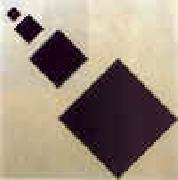 |
Theo van Doesburg
|
|
Dutch
1883-1931
Dutch painter, architect, designer and writer. He was officially registered as the son of Wilhelm Kepper and Henrietta Catharina Margadant, but he was so convinced that his mother second husband, Theodorus Doesburg, was his father that he took his name. Little is known of his early life, but he began painting naturalistic subjects c. 1899. In 1903 he began his military service, and around the same time he met his first wife, Agnita Feis, a Theosophist and poet. Between about 1908 and 1910, much influenced by the work of Honor Daumier, he produced caricatures, some of which were later published in his first book De maskers af! (1916). Also during this period he painted some Impressionist-inspired landscapes and portraits in the manner of George Hendrik Breitner. Between 1914 and 1915 the influence of Kandinsky became clear in such drawings as Streetmusic I and Streetmusic II (The Hague, Rijksdienst Beeld. Kst) and other abstract works. |
|
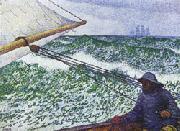 |
Theo Van Rysselberghe
|
|
Belgian Pointillist Painter, 1862-1926
was a Belgian neo-impressionist painter, who played a pivotal role in the European art scene at the turn of the century. Born in Ghent to a French-speaking bourgeois family, he studied first at the Academy of Ghent under Theo Canneel and from 1879 at the Academy of Brussels under the directorship of Jean-François Portaels. The North African paintings of Portaels had started an orientalist fashion in Belgium. Their impact would strongly influence the young Theo van Rysselberghe. Between 1882 and 1888 he made three trips to Morocco, staying there a total of one year and half. Barely 18 years old, he already participated at the Salon of Ghent, showing two portraits. Soon afterwards followed his Self-portrait with pipe (1880), painted in somber colours in the Belgian realistic tradition of that time. His Child in an open spot of the forest (1880) already departs from this style and he sets his first steps towards impressionism. |
|
|
|
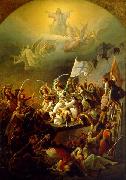 |
Theodoros Vryzakis
|
|
Thebes 19 October 1814 - Munich 6 December 1878) was a major Greek painter of the 19th century.
Vryzakis's father died in the Greek War of Independence. He is the first Greek painter who studied in Munich and the main representative of the type of historical painting that was popular in Greece in the 18th century.
He is considered the first painter of modern Greece, a recorder of the Greek War of Independence, which he viewed in a romantic and nostalgic way. His paintings' characters are pompous, theatrical and detached figures. His interest in the traditional costumes and the decoration and the absence of any individual facial expression is according to art critics the result of the eye of a "foreign" artist, who looks for the conventional element in another land. The monumental size of his pictures, the ceremonial and theatrical compositions, and the meticulous style of academic idealistic romanticism make his style unique for among Greek Artists. Today, many of his works are exhibited at the National Gallery of Athens and the Benaki Museum in Athens.
|
|
|
|
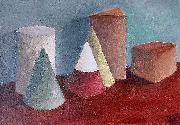 |
Tim Verfaillie
|
|
(Brugge, 14 January 1893 - Rochefort, 1934) was Belgian painter who was one of the smaller figures of Flemish expressionism.
In his younger days he travelled through the Scottish Highlands. The atmosphere he witnessed there would remain an important influence in his work.
|
|
 |
TIZIANO Vecellio
|
|
Italian painter, Venetian school (b. 1490, Pieve di Cadore, d.
1576, Venezia). |
|
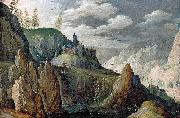 |
Tobias Verhaecht
|
|
(Antwerp, 1561 - 1631) was a painter and draughtsman active in Antwerp, Florence and Rome. Primarily a landscape painter, his style is indebted to mannerist world landscapes of artists like Joachim Patinir with high viewpoints, fantastic distant perspectives and three-colour scheme. Before Verhaecht entered Antwerp's guild of St. Luke in 1590-91, he had already spent time in Italy, first in Florence, and then as a fresco painter in Rome. Peter Paul Rubens, who was a relative by marriage, studied with him around 1592, and another student was his own son, Willem van Haecht. Verhaecht is also known for his designs for prints.
|
|
 |
Tobias Verhaeght
|
|
1561-1631
was a painter and draughtsman active in Antwerp, Florence and Rome. Primarily a landscape painter, his style is indebted to mannerist world landscapes of artists like Joachim Patinir with high viewpoints, fantastic distant perspectives and three-colour scheme. Before Verhaecht entered Antwerp's guild of St. Luke in 1590?C91, he had already spent time in Italy, first in Florence, and then as a fresco painter in Rome. Peter Paul Rubens, who was a relative by marriage, studied with him around 1592, and another student was his own son, Willem van Haecht. |
|
|
|
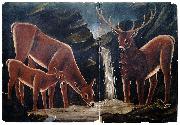 |
Vaclav Brozik
|
|
(5 March 1851 - 15 April 1901) was a Czech academic painter.
Since 1868 he studied at the Academy of Arts in Prague, Dresden, and Munich. In 1879 he went on study journey to the Netherlands.
He married a daughter of a wealthy art dealer in Paris, who helped him achieve success in French high society. He divided his time between Prague, where he taught at the Academy since 1893, and Paris. In 1896 he was elected as a foreign member and the successor of John Millais in the French Academie des beaux-arts. He died suddenly of cardiac failure and is buried at the Cimetiere de Montmartre.
|
|
 |
Vaclav Vavrinec Reiner
|
|
(Czech: Vaclav Vavřinec Reiner; 8 August 1686 or 1689 - 9 October 1743) was a Baroque painter who lived and died in Prague, Bohemia. |
|
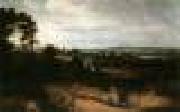 |
VADDER, Lodewijk de
|
|
Flemish painter (b. 1605, Bruxelles, d. 1655, Bruxelles)
Flemish painter, draughtsman, engraver and tapestry designer. He was received as a master in the Brussels Guild of St Luke on 15 May 1628, probably, like his brother Hubert de Vadder, after an apprenticeship to his elder brother, Philippe de Vadder (Coeckelberghs). Lodewijk is best known as a landscape painter, although he also executed landscape engravings and drawings. He was granted a privilege to make tapestry cartoons by the Brussels city magistrate in 1644. In this capacity he worked mainly for weavers such as Jean Courdijn and Baudouin van Beveren. The latter referred to him as the best landscape painter in the country |
|
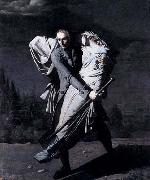 |
VAFFLARD, Pierre-Auguste
|
|
French painter b. 1777, Paris, d. 1837, Paris,French painter. A pupil of Jean-Baptiste Regnault, he exhibited regularly in the Salon between 1800 and 1831. He executed a number of unremarkable academic works on Classical subjects, for example Electra (1804; exh. Salon 1814) and Orestes Sleeping (1819; both Dijon, Mus. B.-A.). Vafflard gained more success with his Troubadour pictures, which he began to paint in the early 19th century, at the outset of this fashion. They are remarkable for their absence of colour, their theatrical quality and contrasted lighting effects. One of his earliest Troubadour scenes was Emma and Eginhard (exh. Salon 1804; Evreux, Mus. Evreux), based on an episode in the history of Charlemagne's court and painted at a time when the Holy Roman Empire was in fashion in official French circles. In this sentimental painting Vafflard demonstrated his historicizing intentions by emphasizing medieval costume and Gothic architecture and seeking to create an atmosphere similar to the romans de la chevalerie, so highly thought of in France at the end of the 18th century. In the same Salon he exhibited a strange and novel painting, Young Holding his Dead Daughter in his Arms (Angouleme, Mus. Mun.), taken from Edward Young's Night Thoughts (pubd in French in 1769-70). |
|
|
|
 |
Valentin Aleksandrovich Serov
|
|
Russian Painter, 1865-1911
Russian painter, graphic artist and stage designer. As a child he lived in St Petersburg, but he made frequent trips abroad. In 1874 he travelled to Paris with his mother and frequented the studio of the Russian Realist painter, Il'ya Repin. In 1875 the art patron Savva Mamontov invited Serov and his mother to settle at ABRAMTSEVO outside Moscow, where he again had the opportunity to study under Repin and to meet other artists in the Mamontov circle. The Symbolist paintings of Mikhail Vrubel' and the late Impressionist landscapes and figure studies of Konstantin Korovin he saw at Abramtsevo had a lasting influence on the young Serov. From 1880 to 1885 he studied at the Academy of Art, St Petersburg, under Pavel Chistyakov (1832-1919). During the 1880s Serov also travelled abroad and became aware of French Impressionism. He began to use bright colours in portraits of figures seen in dappled sunlight and shade, as in his portrait of Vera Mamontov, Girl with Peaches (1887) and a portrait of Mariya Simonovich, Girl in Sunlight (1888; both Moscow, Tret'yakov Gal.). |
|
|
|
|
|
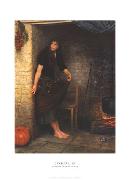 |
Valentine Cameron Prinsep Prints
|
|
Indian-born British Pre-Raphaelite Painter, 1838-1904
Henry Prinsep was an intimate friend of G. F. Watts, under whom his son first studied. Val Prinsep also worked in Paris in the atelier Gleyre; and 'Taffy' in his friend George du Maurier's novel Trilby, is said to have been sketched from him. He was an intimate friend of John Everett Millais and of Burne-Jones, with whom he travelled in Italy. He had a share with Rossetti and others in the decoration of the hall of the Oxford Union.
Prinsep first exhibited at the Royal Academy in 1862 with his Bianca Capella, his first picture, which attracted marked notice, being a portrait (1866) of General Gordon in Chinese costume. Princep lent the costume to Millais who used it in his own painting Esther.
The best of his later exhibits were A Versailles, The Emperor Theophilus chooses his Wife, The Broken Idol and The Goose Girl. He was elected A.R.A. in 1879 and R.A. in 1894. In 1877 he went to India and painted a huge picture of the Delhi Durbar, exhibited in 1880, and afterwards hung at Buckingham Palace. |
|
|
|
|
|
|
|
|
|
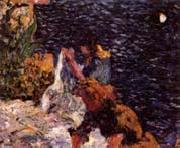 |
Valtat Louis
|
|
Dieppe 1869-Choisel 1952
French painter, printmaker and stage designer. He spent much of his youth in Versailles, moving in 1887 to Paris, where he studied under Gustave Moreau at the Ecole des Beaux-Arts and under Jules Dupre at the Acad?mie Julian. There he met Maurice Denis, Pierre Bonnard, Edouard Vuillard and Albert Andre. With a keen interest in both artistic precedents and contemporary trends, he absorbed in the mid-1890s the chief tenets of Impressionism, van Gogh's work and Pointillism before slowly developing his own style. |
|
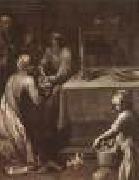 |
VARIN, Quentin
|
|
French Painter, ca.1570-1634
French painter. He was the son of a shoemaker and from 1597 to 1600 was in the papal territory of Avignon, where he worked with a local painter, Pierre Duplan ( fl late 16th century), enrolling also in the local painters' guild. By 1607 he had returned to northern France, and he was married that year at Amiens. In 1612 he was working in the Norman village of Les Andelys, and there he became Nicolas Poussin's first master. For the Gothic church of Notre-Dame, Le Grand Andely, he produced in 1612 a Martyrdom of St Vincent, a Martyrdom of St Clarus and a Regina Coeli (all in situ), the works that provided Poussin with his first contact with contemporary painting. These are the earliest fixed points in Varin's oeuvre, although a ruined Rock of the Philosophers (Rouen, Mus. B.-A.), reminiscent of such late 16th-century French Mannerist painters as Antoine Caron, |
|
|
|
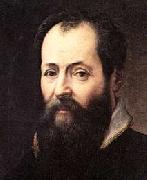 |
VASARI, Giorgio
|
|
Italian Mannerist Writer and Painter, 1511-1574
Italian painter, architect, and writer. Though he was a prolific painter in the Mannerist style, he is more highly regarded as an architect (he designed the Uffizi Palace, now the Uffizi Gallery), but even his architecture is overshadowed by his writings. His Lives of the Most Eminent Architects, Painters, and Sculptors (1550) offers biographies of early to late Renaissance artists. His style is eminently readable and his material is well researched, though when facts were scarce he did not hesitate to fill in the gaps. In his view, Giotto had revived the art of true representation after its decline in the early Middle Ages, and succeeding artists had brought that art progressively closer to the perfection achieved by Michelangelo. |
|
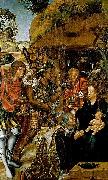 |
Vasco Fernandes
|
|
Vasco Fernandes (c.1475-c.1542), better known as Grão Vasco, was one of the main Portuguese Renaissance painters.
Vasco Fernandes was probably born in Viseu, in Northern Portugal, where he began his career in the team of painters executing the main altarpiece of Viseu Cathedral (1501-1506). Between 1506 and 1511 he painted the main altarpiece of Lamego Cathedral. After working in the Santa Cruz Monastery of Coimbra, Vasco Fernandes returned to Viseu and executed a series of altarpieces for Viseu Cathedral, considered his main works.
Most of his paintings hang nowadays in the Grão Vasco Museum, in Viseu. |
|
|
|
|
|
 |
Vasiliy Polenov
|
|
Vasily Dmitrievich Polenov (Russian: 1 June 1844 - 18 July 1927) was a Russian landscape painter associated with the Peredvizhniki movement of realist artists.
BiographyA native of St.Petersburg, Polenov studied under Pavel Chistyakov and in the Imperial Academy of Arts from 1863 to 1871. He was classmate and close friend to Rafail Levitsky, fellow Peredvizhniki artist and famous photographer. Their letters which remain today in Polenov's house museum are an interesting account of the many art exhibitions, movements and artists of their day. |
|
|
|
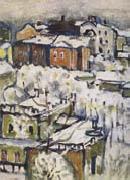 |
Vasily Kandinsky
|
|
b. Dec. 4 ,Dec. 16, New Style, 1866, Moscow, Russia--d. Dec. 13, 1944, Neuilly-sur-Seine, Fr.
Wasilly Kandinsky (or Vassilii Kandinskii) was a Russian painter whose works from 1910 are considered the first abstract paintings. Kandinsky had a law career in Moscow until he opted for art school in Munich in 1896 -- when he was almost 30. Within a decade he'd made a name for himself in Russia and in Europe, an Expressionist whose dazzling watercolors were influenced by Russian folk art and French Impressionists such as Claude Monet. Between 1910 and 1912 he wrote about non-objective "abstract" paintings and published On the Spiritual in Art, a work that solidified his position as the father of abstract art. Known for his ingenuity with geometric shapes and use of brilliant color, Kandinsky was successful in Europe and the United States. |
|
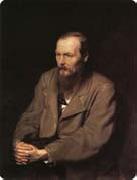 |
Vasily Perov
|
|
Russian historical, genre, and portrait Painter , 1834-1882
was a Russian painter and one of the founding members of Peredvizhniki, a group of Russian realist painters. Vasily Perov was born January 2, 1834 (December 21 1833 Old Style) in Tobolsk. After completing a course at Arzamas uezd school, he was transferred to the Alexander Stupin art school also located in Arzamas. In 1853 he was admitted to the Moscow School of Painting, Sculpture and Architecture, where he learned from several renowned artists. In 1856 he was awarded with a minor silver medal for his sketch of a boy's head, presented to the Imperial Academy of Arts. Later the Academy awarded him many other awards: in 1857 a major silver medal for Commissary of Rural Police Investigating, a minor golden medal for the Scene on a Grave and the Son of a dyak promoted to first rank, in 1861 a major golden medal for Sermon in a Village. After receiving the right to a state-paid trip abroad together with a golden medal, in 1862 Perov went to Western Europe, visiting several German cities, and then Paris. During this time he created paintings depicting scenes from European street life such as the Vendor of statuettes, the Savoyard, the Organ-Grinder in Paris, the Musicians and the Bystanders, the Paris Ragpickers. Returning to Moscow early, from 1865 to 1871 Perov created his masterpieces The Queue at The Fountain, A Meal in the Monastery, Last Journey, Troika, the Lent Monday, Arrival of a New Governess in a Merchant House, the Drawing Teacher, A Scene at the Railroad, the Last Tavern at Town Gate, the Birdcatcher, the Fisherman, the Hunters at Rest. In 1866 he received the title of an academician, and in 1871 the position of a Professor at Moscow School of Arts, Sculpture and Architecture. |
|
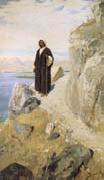 |
Vasily Polenov
|
|
1844 - 1927,Painter. He began a systematic study of drawing in 1856, first with the landscape painter Pavel Cherkasov (1834-1900), then from 1859 to 1861 with Pavel Chistyakov (1832-1919). He also took lessons with Chistyakov, whom he considered his most important teacher, in 1871 and early 1872, after finishing his academic course. From 1863 to 1871 Polenov studied at the St Petersburg Academy of Art, where he met members of the progressive wing of the Russian artistic intelligentsia, and occasionally in the faculty of law at St Petersburg University. The classical education he received at home, his academic training and lessons with Chistyakov led Polenov towards an exalted history painting, although he personally inclined towards landscape. This dualism remained in Polenov work for the duration, and not until the late 1880s and early 1890s did he achieve a stable relationship between the two forms. The whole of his student career and the initial postgraduate, scholarship period was largely taken up with historical works: from academic compositions, for example the Resurrection of Jairus Daughter (1871; Pskov, Mus. Hist., Archit. & A.), for which he received the Grand Gold Medal and a travel bursary (in Germany and Italy, 1872-3, and France, 1873-6), to numerous pictures and sketches on subjects from antiquity and medieval history, executed in France or shortly after his departure from there, under the perceptible influence of Paul Delaroche (e.g. The Master Right, 1874; Moscow Tret yakov Gal.). At the same time he produced his first independent works, in the 1860s and early 1870s: landscapes in the surroundings of the Imochentsy estate in Karelia (e.g. Mountains, 1870; Moscow Tret yakov Gal.), and landscape studies and pictures executed from nature in Normandy in 1874 (e.g. Fishing Boat, Etretat; Moscow, Tret'yakov Gal.). In 1876 he became an Academician |
|
 |
Vasily Surikov
|
|
Russian Painter, 1848-1916
Russian painter. He is principally noted for his treatment of episodes from the 17th century and the medieval period of Russian history. These works are remarkable for their thoroughly researched and detailed rendering of settings and costume and the drama of their presentation. Surikov was also an accomplished portrait painter and incorporated a large number of portrait studies into his history paintings. |
|
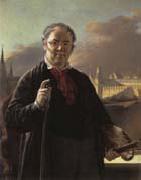 |
Vasily Tropinin
|
|
1776-1857
Russian painter. He was born a serf and in 1790 was apprenticed to a pastrycook in St Petersburg. From 1793 he attended classes at the Academy of Art there, in 1799 becoming a pupil of the portrait painter Stepan Shchukin (1762-1828). In 1804 he was sent to work as a pastrycook and manservant on an estate in the Ukraine owned by his master, General Morkov. Tropinin's Ukrainian period (1804-21) was interrupted by frequent, often protracted, visits to Moscow. During these years he copied a great deal, drew landscapes from nature and also painted religious subjects. His early style is painterly and distinguished by freedom of execution and skill in the use of colour, but the compositions are derivative and the drawing weak: The Spinner (1820s), The Lacemaker (1823), Wedding in the Village of Kukavka, Podolsky Province and Girl with a Bird (all Moscow, Tret'yakov Gal.). Portraiture, however, began to take on a more important place in his work; the best of this period is the Portrait of Arseny, the Artist's Son (1818; Moscow, Tret'yakov Gal.), especially notable for its use of colour. Tropinin captured perfectly the child's spontaneous vision of the world, his sensitive spirit and openness. While in Moscow from 1813 to 1818, he portrayed a series of important cultural figures that brought him great popularity. He was freed from serfdom on 8 May 1823 and shortly thereafter he became a nominee to the Academy for his paintings The Lacemaker |
|
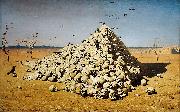 |
Vasily Vereshchagin
|
|
(Russian: October 26, 1842 - April 13, 1904) was one of the most famous Russian battle painters and one of the first Russian artists to be widely recognized abroad. The graphic nature of his realist scenes led many of them to never be printed or exhibited.
Vereshchagin was born at Cherepovets, Novgorod Governorate, Russia in 1842 as the middle of three brothers. His father was a landowner of noble birth. When he was eight years old he was sent to Tsarskoe Selo to enter the Alexander Cadet Corps, and three years later he entered the Sea Cadet Corps at St Petersburg, making his first voyage in 1858. He served on the frigate Kamchatka, which sailed to Denmark, France and Egypt.
Vereshchagin graduated first in the list at the naval school, but left the service immediately to begin the study of drawing in earnest. He won a medal two years later, in 1863, from the St Petersburg Academy for his Ulysses Slaying the Suitors. |
|
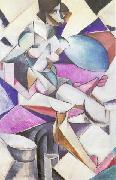 |
Vassilieff
|
|
Mariya Ivanovna Vassilieva (Russian/, February 12, 1884 - May 14, 1957), better known as Marie Vassilieff, was a Russian painter. |
|
 |
Vassily Kandinsky
|
|
Russian-born French Expressionist Painter , 1866-1944
was a Russian painter, printmaker and art theorist. One of the most famous 20th-century artists, he is credited with painting the first modern abstract works. Born in Moscow, Kandinsky spent his childhood in Odessa. He enrolled at the University of Moscow and chose to study law and economics. Quite successful in his profession??he was offered a professorship (chair of Roman Law) at the University of Dorpat??he started painting studies (life-drawing, sketching and anatomy) at the age of 30. In 1896 he settled in Munich and studied first in the private school of Anton Azbe and then at the Academy of Fine Arts, Munich. He went back to Moscow in 1914 after World War I started. He was unsympathetic to the official theories on art in Moscow and returned to Germany in 1921. There he taught at the Bauhaus school of art and architecture from 1922 until the Nazis closed it in 1933. |
|
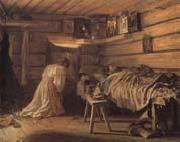 |
Vassily Maximov
|
|
Russian 1844-1911,was a Russian painter, a prominent member of the Peredvizhniki group. Maximov was born to a peasant family in the village of Lopino near Novaya Ladoga. He became an orphan early and worked for an Iconpainting shop, where he first learned to paint. In 1863 he entered the Imperial Academy of Arts and in 1864 he became a member of an Artel of Artists created by P.N. Krestonovtsev by the example of Ivan Kramskoi. The artel existed only one year and was then disbanded. Maximov painted the Sick Child (1864) at that time, when received a Gold Medal of the Academia. He completed all the courses of the Academy in three years. In 1865 he (like the group of fourteen led by Ivan Kramskoi had done earlier) refused to take part in the competitions for the Major Gold Medal by Academia. He argued that he did not need to study abroad (that was a part of the prize) but rather would study the Russian village. Indeed, after graduation from the Academia he moved to the village of Shubino, in the gubernia of Tver, where he painted the peasant life, earning money as a painting teacher of the Princes Golenischev Kutuzov (descendants of Mikhail Illarionovich Kutuzov). His painting Grandmother tales (1867) was shown at a Peredvizhniki exhibition, where it won a prize and was bought by Pavel Tretyakov. In 1872 he was admitted to the Peredvizhniki group, and soon became one of its most prominent and rigorous members. Ilya Yefimovich Repin described Maximov as the most uncrushable stone in the foundation of peredvizhnechestvo. Maximov painted many paintings of the peasant life. In the last twenty years of his life, realism paintings fell out of fashion. Maximov still painted almost exclusively scenes of the peasant lives that had almost no buyers. The artist lived a life full of poverty and illnesses. He died in Saint Petersburg. |
|
|
|
 |
Vecchietta
|
|
Italian Early Renaissance Painter and Sculptor, ca.1410-1480
Italian painter, sculptor, goldsmith and architect. He was formerly believed to have been born c. 1412 in the Tuscan town of Castiglione d'Orcia, but del Bravo has identified him with the Lorenzo di Pietro di Giovanni who was baptized in Siena in 1410. His name appears in a list of the members of the Siena painters' guild in 1428. From the evidence of later works he is generally supposed to have been apprenticed to Sassetta, but his early work has not been identified. Between c. 1435 and 1439 he executed for Cardinal Branda Castiglione (1350-1443) a series of frescoes at Castiglione Olona, near Varese in Lombardy. He has been considered an assistant of MASOLINO DA PANICALE in this enterprise, but the scenes of the martyrdoms of SS Lawrence and Stephen in the apse of the Collegiata, below Masolino's vault frescoes, show that Vecchietta's closely packed compositional style was already fully formed. He also painted the frescoes (partially published by Bertelli) in the chapel of the Cardinal's palace in the town, depicting the Evangelists (vault) and friezes of male and female saints (side walls). Although abraded and fragmentary, they nevertheless indicate the naturalistic effects of atmospheric lighting and foreshortening that, more than any other Sienese painter of his day, he had learnt from Masolino and the Florentine painters. |
|
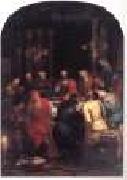 |
VEEN, Otto van
|
|
Flemish painter (b. 1556, Leiden, d. 1629, Bruxelles).
Flemish painter and draughtsman of Dutch birth. Although born in Holland, he is regarded as an artist of the Catholic southern Netherlands, where he spent most of his active life. He seems to have been acquainted with most of the Netherlandish scholars of his time, and his works testify to his broad humanistic learning. This and his prominent role in the early manifestations of the Counter-Reformation in Antwerp may have led Rubens to choose him as a teacher. Van Veen's importance as an artist has often been compared to the career of his famous pupil, for whom he was certainly the most important exemplar of the pictor doctus or learned painter. Van Veen obviously represents the older generation's more classicizing and conservative response to the Counter-Reformation. For him, the return to the spiritual values of the past also implied a recovery of the pictorial style of the High Renaissance, with its deliberate borrowings from the paintings of such artists as Raphael and Correggio. |
|
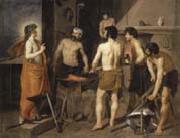 |
Velasquez
|
|
1599-1660,Spanish painter. He was apprenticed to Francisco Herrera the Elder before being trained by Francisco Pacheco. His early works were mostly religious or genre scenes. After arriving in Madrid in 1623, he painted a portrait of Philip IV that won him immediate success and an appointment as court painter. His position gave him access to the royal collections, including works by Titian, who exerted the greatest influence on his style. In his portraits from this period, only the faces and hands of the figures are accentuated, and the dark figures stand out against a light background. A visit to Italy (1629 ?C 31) further developed his style, and on his return to Madrid he entered his most productive period. Velazquez created a new type of informal royal portrait for Philip hunting lodge, and his portraits of court dwarfs display the same discerning eye as those of his royal subjects. On a second visit to Rome (1649 ?C 51) he painted a portrait of Pope Innocent X. The powerful head, brilliant combinations of crimson of the curtain, chair, and cope are painted with fluent technique and almost imperceptible brushstrokes that go far beyond the late manner of Titian and announce the last stage in Velazquez development. This portrait was copied innumerable times and won him immediate and lasting renown in Italy. In his last years he created his masterpiece, Las Meninas (The Maids of Honour, 1656). In this casual scene, the artist is shown painting the king and queen in the presence of the infanta Margarita and her attendants; the nearly life size figures are painted in more or less detail according to their relation to the central figure of the infanta and to the source of light, creating a remarkable illusion of reality never surpassed by Velazquez or any other artist of his age. He is universally acknowledged as one of the giants of Western art. |
|
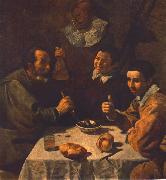 |
VELAZQUEZ, Diego Rodriguez de Silva y
|
|
Spanish Baroque Era Painter, 1599-1660
Spanish painter. He was one of the most important European artists of the 17th century, spending his career from 1623 in the service of Philip IV of Spain. His early canvases comprised bodegones and religious paintings, but as a court artist he was largely occupied in executing portraits, while also producing some historical, mythological and further religious works. His painting was deeply affected by the work of Rubens and by Venetian artists, especially Titian, as well as by the experience of two trips (1629-31 and 1649-51) to Italy. Under these joint influences he developed a uniquely personal style characterized by very loose, expressive brushwork. |
|
 |
velazqufz
|
|
1625-30
devonshire collection, chatsworth |
|
|

